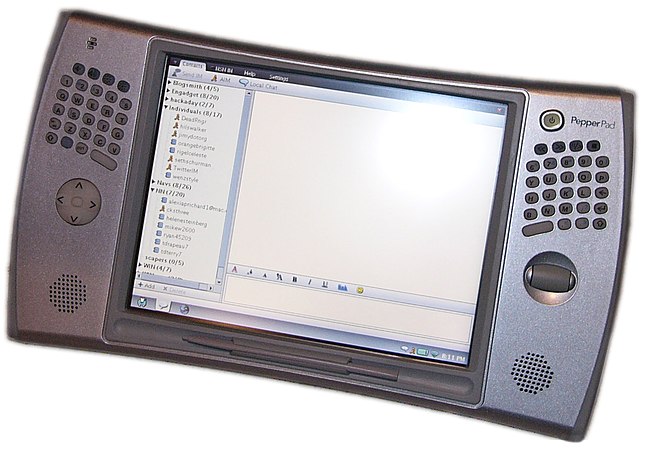History of video games/Platforms/Pepper Pad
-
A Pepper Pad 2
History
[edit | edit source]Development
[edit | edit source]In January of 2002 Pepper computer was founded in Lexington, Massachusetts.[1]
On December 17th, 2003 the Pepper Pad Wi-Fi Suite was announced.[1] This hardware was later demoed at CES 2004.[1]
Launches
[edit | edit source]The Pepper Pad was launched in 2005.[2]
The Pepper Pad 3 was launched in 2006.[3]
Legacy
[edit | edit source]Sales were not good, leading to the Pepper company downsizing in 2007.[4]
Pepper Pad Wi-Fi Suite Technology
[edit | edit source]Compute
[edit | edit source]
The Pepper Pad Wi-Fi suite is powered by an Intel XScale PXA255 clocked at 400 megahertz.[5] This CPU was based on the strongARM architecture.[6]
The Pepper Pad Wi-Fi suite has 256 megabytes of SDRAM.[5]
The system has a 2D graphics accelerator on the LCD controller.[5]
Hardware
[edit | edit source]The Pepper Pad Wi-Fi suite has 32 megabytes of flash storage, and a 1.8 inch PCMCIA 5 gigabyte hard drive.[5] An SD card slot is used for expandable storage.[5]
The Pepper Pad has a 8.4 inch TFT LCD touchscreen with a resolution of 600 by 800 pixels.[5]
The Pepper Pad Wi-Fi suite supports Wi-Fi b with dual antennas, and also supports bluetooth.[5]
The Pepper Pad is powered by two lithium polymer batteries in series to provide a capacity of 3400mAh.[5]
Software
[edit | edit source]The Pepper Pad Wi-Fi Suite runs Linux 2.4 and supports Java applications.[5]
Pepper Pad 2 Technology
[edit | edit source]Compute
[edit | edit source]The Pepper Pad 2 Intel XScale CPU is clocked at 624 megahertz.[7][8]
Hardware
[edit | edit source]The Pepper Pad 2 has a 20 gigabyte hard drive and an SD card slot.[7][8]
The display of the Pepper Pad 2 is a 8.4" TFT touchscreen with a resolution of 800 by 600 pixels.[7][8]
The Pepper Pad 2 has Wi-Fi g and Bluetooth.[7]
Software
[edit | edit source]The Pepper Pad 2 runs MontaVista Linux CEE.[8]
Pepper Pad 3 Technology
[edit | edit source]Compute
[edit | edit source]
The Pepper Pad 3 is powered by an AMD Geode LX800 processor clocked at 533 megahertz, and consuming between 0.9 and 1.8 watts of power.[9][10][11][3] The system has 256 megabytes of RAM.[9][10]
Hardware
[edit | edit source]The Pepper Pad 3 has 20 gigabytes of hard drive storage.[9][10]
The Pepper Pad 3 uses a 7" CCFL lit LCD touchscreen with a resolution of 800 by 480 pixels.[10]
Communication supported include Wi-Fi b/g, Bluetooth 2 + EDR, and IrDA.[11]
The system is powered by a lithium polymer battery, which lasts around two to four hours.[11][12]
Software
[edit | edit source]The Pepper Pad 3 runs Red Hat Linux with a kernel version 2.6.[9][10]
References
[edit | edit source]- ↑ a b c "MontaVista Linux Revs Up New Pepper Pad for Instant Sharing and Collaboration". www.businesswire.com. 5 January 2004.
- ↑ "Pepper Computer Launches The Pepper Pad; First Consumer Device to Combine Broadband Internet Access, Digital Media and Home Control in Convenient, Portable Form". www.businesswire.com. 19 May 2005.
- ↑ a b "Pepper Computer announces Pepper Pad 3". Engadget. Retrieved 6 November 2020.
- ↑ "Pepper Computer: "we're not dead"". Engadget. Retrieved 6 November 2020.
- ↑ a b c d e f g h i "Wayback Machine". web.archive.org. 17 April 2004.
- ↑ "Intel-PXA255 processor board is (much) smaller than a credit card".
- ↑ a b c d "The Pepper Pad 2". Engadget. Retrieved 6 November 2020.
- ↑ a b c d Sosik-Hamor, Sean (10 September 2004). "Pepper Pad 2 Linux Web Pad". Inert Ramblings. Retrieved 6 November 2020.
- ↑ a b c d "Pepper Pad 3 - tablet - Linux 2.6 - 20 GB - 7" Series Specs". CNET. Retrieved 6 November 2020.
- ↑ a b c d e "Pepper Computer Pepper Pad 3 full specfications, info". www.umpcportal.com. Retrieved 6 November 2020.
- ↑ a b c "Pepper Pad HPAB20256 Pepper Pad 3 handheld web computer Black - Newegg.com". www.newegg.com. Retrieved 6 November 2020.
- ↑ Sherwood, James. "Pepper Pad 3 Linux UMPC arrives in UK". www.theregister.com. Retrieved 6 November 2020.

